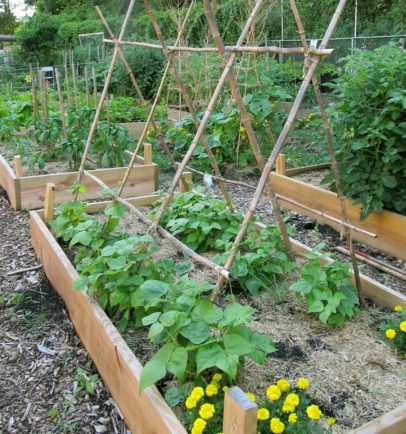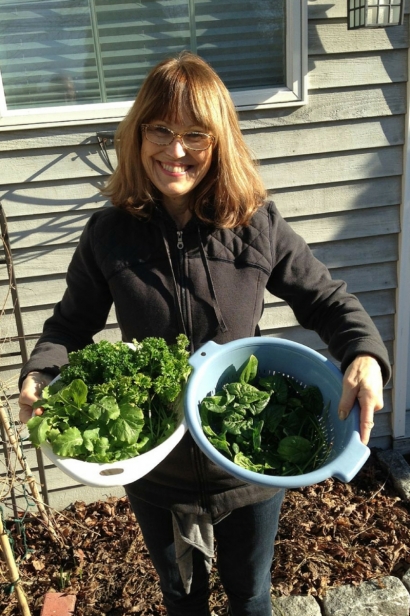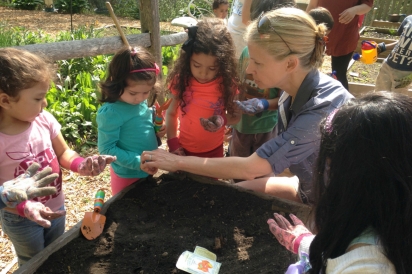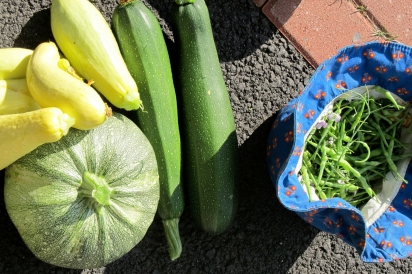The Thrill of the Harvest at Armstrong Court Community Garden
The Armstrong Court Community Garden in Greenwich is an enchanting bazaar of edible plants, checkered with cleverly constructed architecture by amateur farmers. Under the colorful tent of an open sky, gardeners coax tomatoes and runner beans to grow tall by tying them to stakes of bamboo and Crayola-colored squiggly metal poles. Tendrils of cucumbers scamper through yards of strings, pinky-thin, and ropes thumb-wide, woven between wooden poles. Gray hoops, trellises, and arched white PVC pipes tame errant vegetables that would run rampant if not taught to behave. And to keep the neighboring rascal groundhog out of the raised beds, the garden is webbed with all manner of fences and gates, some rudimentary, others handsomely decorative, each crafted by a skillful suburban gardener.
The garden beds are filled with a loam so rich with organic nutrients that deeply veined kale is almost Jurassic in width and height, and just one leaf of iridescent green lettuce, heavy with shimmering, silvery dew, long into late morning, would make a salad for two.
A First For Greenwich
This was the first community garden in a town better known for its large estates of manicured lawns, swaths of open space, and magnificent mansions. Little known is the fact that Greenwich is also host to affordable housing units, such as Armstrong Court, where this garden is located.
In 2009 master gardener Patty Sechi decided to follow through with an idea she had long harbored: Find some ground where local residents without access to open land could grow organic produce for themselves and those in need. Along the way, build a community of people from different backgrounds and of all ages.
“Our mission,” says Patty, an aspiring gardener since the age of 9, “is dedicated to organic gardening, sustainable living, and the belief that community gardens can change health, wellness, and the attitudes of the gardeners they serve.”
It was a noble concept and, on paper, the proposal seemed simple enough. In actuality, it took guts and determination and the vision of a handful of people who committed untold hours for the common good. Patty led a group of volunteers wielding machetes through jungle-like growth to clear 15,000 square feet of brush, thigh-high weeds, and prickly vines in a 500-square-foot, narrow back lot that was a vegetable field about 30 years ago. Today that area flourishes with 125 raised beds of vegetables, herbs, and flowers carefully tended by Armstrong tenants as well as other town residents.
Then last summer, Patty took her concept one step further. On Bible Street, in the Cos Cob hamlet of town, where a vacant lot was used for leaf composting by the town, Patty envisaged a community garden instead. The one-acre Bible Street plot sits directly across the road from the Garden Education Center of Greenwich in an area that is a vast, verdant woodland of open space. This open space encompasses close to 100 acres in Montgomery Pinetum Park, the Mildred Caldwell Sanctuary, and the Pomerance/Tuchman properties. Horse trails crisscross the land as do walking trails. Today the Bible Street Community Garden encompasses 100 beds, bringing the town total to 225 beds. It’s quite an achievement.
Community Gardening
Cordalie Benoit of the Connecticut Community Gardening Association says that “every city and almost all towns in the state now have a community garden. I think all the towns in Fairfield County have a community garden … Bridgeport has many gardens, and some towns have several locations.” According to the American Community Gardening Association, there are more than 10,000 diverse locations across the country where gardeners without land of their own come together to create community gardens.
Edith and Charlie Meli are two such gardeners. Last summer, Edith, who was working at Pet Pantry in town, met Patty Sechi when she came in to shop. Patty told her about the Cos Cob site and the couple, who live in the housing complex Agnes Morley Heights, quickly signed on for one of the four-by-eight-foot raised beds.
“We don’t have ground at our place for a garden,” Charlie explains, “and we really wanted to grow vegetables of our own.” Edith adds that they are already anticipating the bounty of their harvest. “We are going to plant beets, carrots, steak tomatoes and cherry tomatoes and peppers,” she says as she pulls weeds from the bed while Charlie loads a wheelbarrow of soil from an immense mound of organic black dirt to fill their plot. That mound of dirt sits outside the eight-foot metal fence that surrounds the community garden.
“Food is not just fuel. Food is about family, food is about community, food is about identity,” Michael Pollan once said. His words resonate here. Dr. Amy Zabin was just about to transplant young tomato and basil plants (“I love pesto,” she murmurs) into her bed when Troudy Gouse, whose green thumb is well known in town, stopped her. “You’ve got to first pull up those weeds because they’ll just push up through whatever soil you pile on top of them.” And then she bent down alongside Amy to do just that. The weed was bagged for garbage disposal, not for the compost heap.
“You develop a relationship with people, even with birds, beetles, spiders, nematodes, and ants,” explains Patty. “It’s about harmony—working with nature.”
For and By the Community
On a misty June afternoon under ashen skies at the Armstrong Court garden, Ann Shifman-Deibler was shearing a thicket of arugula. “It’ll come back,” Ann says of the spicy green. “I’ll get more than one crop from this patch.” Ann packs the herb into baggies earmarked “Neighbor to Neighbor” as a donation from the First Methodist Church in Greenwich, which leases the plot.
Over the last four years, Greenwich Community Gardens has delivered more than 1,500 pounds of fresh produce to the Neighbor to Neighbor food pantry, says Patty as she rips leaves off newly cut bamboo stakes. More than 1,000 people depend on this service every week. The Bible Street endeavor with its 100 beds has increased that donation significantly.
Adults are not the only ones toiling away in this communal cultivation. Youngsters have their own gardening retreat at Armstrong: a butterfly garden with perennials like nepeta, butterfly weed, echinacea, bee balm, foxglove, and lamb’s ears, and annuals like sunflowers—a floral feast to lure the monarch butterfly and the hummingbird. It’s an entrancing space made all the more so by a botanical mural painted by local artists Liz van Duyne, Nina Weld, and Jenny Clark on a wall that anchors the garden on one side. In addition, a native plants tract, a vegetable plot, and a scented garden provide learning experiences well beyond the classroom for the children.
There’s much more. A brick pizza oven makes it easy for a former pizzaiolo-now-turned farmer to gussy up his dough with proffered pickings from his and neighbors’ plots while they set out plates on the nearby tables in the rustic dining courtyard. Occasionally, Patty’s musician son, Jesse, drops by to serenade the group.
Perhaps because community gardeners are universally compulsive weeders whose vegetable rows are straight as arrows, the landscapes at both Greenwich sites and particularly at the more established Armstrong have a serenity about them reminiscent of a French potager. Edgings of marigolds; rows of parsley, basil, cilantro, dill and oregano; center beds of peppers and green beans; back canvases of towering tomatoes; and everywhere blue leaves of kale and jeweled leaves of Swiss chard. Besides the satisfaction of the harvest, the gardeners reap lasting friendships that go far beyond the digging and the picking.
Of course, none of this would be possible without adequate funding, especially since monies must be raised by the organization itself without ongoing fiscal help from the town beyond the leasing of the two community gardens for one dollar a year. Deer fences, garden soil, water source, garden paraphernalia like shovels, hoses, and wheelbarrows, tool sheds, garden carts, and wood sides for the beds are all funded by the organization at about $85,000 at start-up and $10,000 a year for maintenance.
So where does the money come from? Mostly through donations from individuals and local garden clubs, which make up the bulk of the coffers, says Patty. “Plus, a couple of foundations support us. And local business people like Summer Rain, who offered their services for free, and Bob Natale, who brought in his equipment to level the land at Bible Street. And the town pitched in, too, helping to remove invasive plants, clearing an access roadway, supplying a Port-a-John.” Gardeners pay $50 a year for each bed in the Bible Street garden and $20 in the Armstrong Court garden.
Everyone gets involved, from garden clubs and Eagle Scouts to Junior League and Audubon Greenwich. There’s no end to the vision. In the works are plans for beehives, and honey, of course. The Bible Street cadre has installed waist-high beds, known in the agricultural lexicon as “enabling gardens,” that can be accessed by people with disabilities and with paths wide enough to accommodate seated gardeners and those in wheelchairs.
Ann and Patty seemed oblivious to the humidity that hung low and hot in the Armstrong garden that June afternoon. The excitement would come later: The thrill of a bountiful harvest is like no other.
For more information, visit here.









